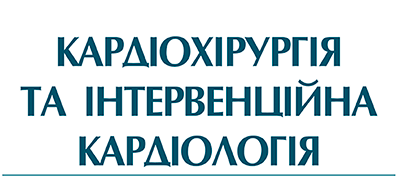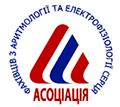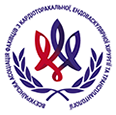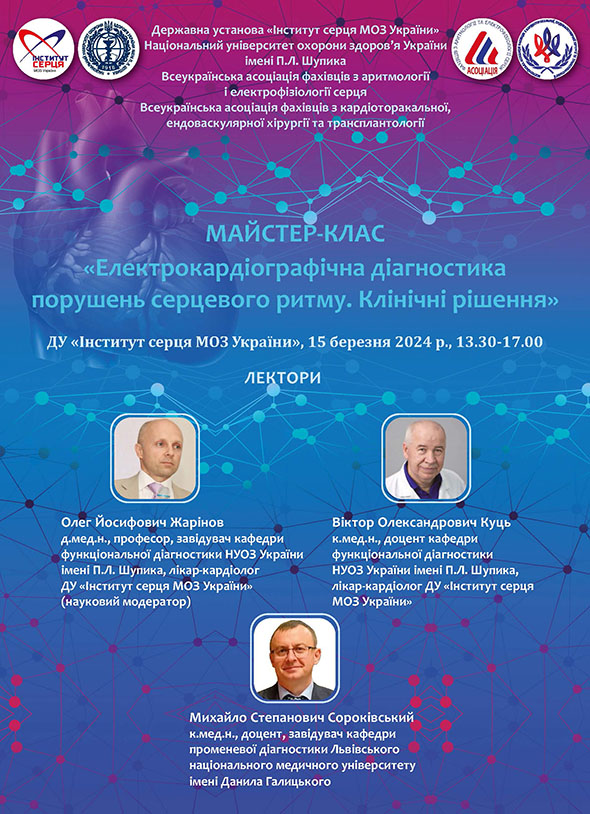Методи лікування фібриляції передсердь у пацієнтів з клапанною патологією серця
О.М. Грицай, Я.В. Скибчик, І.Ю. Мокрик, Є.В. Житинський, В.О. Куць, О.Й. Жарінов, Б.М. Тодуров
Література
- Barnett AS, Kim S, Fonarow GC. et al. Treatment of Atrial Fibrillation and Concordance With the American Heart Association/American College of Cardiology/Heart Rhythm Society Guidelines: Findings From ORBIT-AF (Outcomes Registry for Better Informed Treatment of Atrial Fibrillation). Circ Arrhythm Electrophysiol. 2017;10(11):e00505 doi: 10.1161/CIRCEP.117.005051.
- Barnett SD, Ad N. Surgical ablation as treatment for the elimination of atrial fibrillation: a meta-analysis. J Thorac Cardiovasc Surg. 2006;131(5):1029-1035. doi: 10.1016/j.jtcvs.2005.10.020.
- Calkins H, Kuck KH, Cappato R. et al. HRS/EHRA/ECAS expert consensus statement on catheter and surgical ablation of atrial fibrillation: recommendations for patient selection, procedural techniques, patient management and follow-up, definitions, endpoints, and research trial design. J Interv Card Electrophysiol. 2012;33(2):171-257. doi:10.1007/s10840-012-9672-7
- Compier MG, Braun J, Tjon A. et al. Outcome of stand-alone thoracoscopic epicardial left atrial posterior box isolation with bipolar radiofrequency energy for longstanding persistent atrial fibrillation. Neth Heart J. 2016;24(2):143-151. doi: 10.1007/s12471-015-0785-3.
- Cox J. Current status of the Maze-procedure for the treatment of atrial fibrillation. Seminars Thorac Cardiovasc Surg. 2000;12. Р. 15-19. doi: 10.1016/S1043-0679(00)70011-6.
- Cox JL. The surgical treatment of atrial fibrillation. IV. Surgical technique. J Thorac Cardiovasc Surg. 1991;101(4):584-592. doi: 10.1016/j.hrthm.2009.05.019.
- Cox JL, Boineau JP, Schuessler RB. et al. Modification of the Maze-procedure for atrial flutter and atrial fibrillation. I. Rationale and surgical results. J Thorac Cardiovasc Surg. 1995;110:473-484. doi: 10.1016/S0022-5223(95)70244-X.
- Demaria RG, Page P, Leung TK. et al. Surgical radiofrequency ablation induces coronary endothelial dysfunction in porcine coronary arteries. Eur J Cardiothorac Surg. 2003;23:277-282. doi: 10.1016/s1010-7940(02)00810-2.
- Deneke T, Müller P, Halbfaß P. et al. Effect of Different Ablation Settings on Acute Complications Using the Novel Irrigated Multipolar Radiofrequency Ablation Catheter (nMARQ). J. Cardiovasc Electrophysiol. 2015;26(10):1063-1068. doi: 10.1111/jce.12736.
- Golovchiner G, Mazur A, Kogan A. et al. Atrial flutter after surgical radiofrequency ablation of the left atrium for atrial fibrillation. Ann Thorac Surg. 2005;79(1):108-112. doi: 10.1016/j.athoracsur.2004.06.063.
- Guiraudon GM, Jones DL, Skanes A. et al. Revisiting right atrial isolation rationale for atrial fibrillation: functional anatomy of interatrial connections. J Interv Card Electrophysiol. 2013;37(3):267-273. doi: 10.1007/s10840-013-9804-8.
- Huo Y, Christoph M, Forkmann M. et al. Reduction of radiation exposure during atrial fibrillation ablation using a novel fluoroscopy image integrated 3-dimensional electroanatomic mapping system: A prospective, randomized, single-blind, and controlled study. Heart Rhythm. 2015;12(9):1945-1955. doi: 10.1016/j.hrthm.2015.05.018.
- Ishii Y, Sakamoto SI, Miyagi Y. et al. Risk factors of recurrence of atrial fibrillation (AF) after AF surgery in patients with af and mitral valve disease. Semin. Thorac. Cardiovasc. Surg. 2018;18:44-52. doi: 10.1053/j.semtcvs.2018.01.004.
- Je HG, Shuman DJ, Ad N. Systematic review of minimally invasive surgical treatment for atrial fibrillation: a comparison of the Cox-Maze procedure, beating-heart epicardial ablation, and the hybrid procedure on safety and efficacy. Eur J Cardiothorac Surg. 2015;48(4):531-540. doi: 10.1093/ejcts/ezu536.
- Kim JB, Moon JS, Yun SC. et al. Long-term outcomes of mechanical valve replacement in patients with atrial fibrillation: impact of the Maze procedure. Circulation. 2012;125(17):2071-2080. doi: 10.1161/CIRCULATIONAHA.111.082347.
- Kim JS, Lee JH, Chang HW. et al. Surgical Outcomes of Cox-Maze IV procedure using bipolar irrigated radiofrequency ablation and cryothermy in valvular heart disease. Thorac Cardiovasc Surg. 2011;44(1):18-24. doi:10.5090/kjtcs.2011.44.1.18.
- Kobza R, Hindricks G, Tanner H. et al. Late recurrent arrhythmias after ablation of atrial fibrillation: incidence, mechanisms, and treatment. Heart Rhythm. 2004;1(6):676-683. doi: 10.1016/j.hrthm.2004.08.009.
- Lee R, McCarthy PM, Wang EC. et al. Midterm survival in patients treated for atrial fibrillation: a propensity-matched comparison to patients without a history of atrial fibrillation. J. Thorac Cardiovasc Surg. 2012;143(6):1341-1351. doi:10.1016/j.jtcvs.2012.02.006.
- Liu X, Tan HW, Wang XH. et al. Efficacy of catheter ablation and surgical CryoMaze procedure in patients with long- lasting persistent atrial fibrillation and rheumatic heart disease: a randomized trial. Eur Heart J. 2010;31(21):2633-2641. doi: 10.1093/eurheartj/ehq201.
- Ma W, Shi W, Wu W. et al. Elevated gradient after mitral valve repair: The effect of surgical technique and relevance of postoperative atrial fibrillation. Thorac Cardiovasc Surg. 2018;27:0022-52. doi: 10.1016/j.jtcvs.2018.07.107.
- Maltais S, Forcillo J, Bouchard D. et al. Long-term results following concomitant radiofrequency modified maze ablation for atrial fibrillation. J Card Surg. 2010;25:608-613. doi: 10.1111/j.1540-8191.2010.01087.x.
- Manasse E, Colombo PG, Barbone A. et al. Clinical histopathology and ultrastructural analysis of myocardium following microwave energy ablation. Eur J Cardiothorac Surg. 2003;23(4):573-577. doi: 10.1016/S1010-7940(02)00835-7.
- Negi PC, Mahajan K, Rana V. et al. Clinical Characteristics, Complications, and Treatment Practices in Patients With RHD: 6-Year Results From HP-RHD Registry. Glob Heart. 2018;18:89-99. doi: 10.1016/j.gheart.2018.06.001.
- Paulus K, Stefano B, Dipak K. et al. 2016 ESC Guidelines for the management of atrial fibrillation developed in collaboration with EACTS. Eur Heart J. 2016;37(38):2893-2962. doi: 10.1093/eurheartj/ehw210.
- Pojar M, Haman L, Parizek P. et al. Midterm outcomes of mini-invasive surgical and hybrid ablation of atrial fibrillation. Biomed. Pap. Med. Fac. Univ. Palacky Olomouc Czech Repub. 2018;13:50. doi: 10.5507/bp.2018.050.
- Sardu C, Marfella R, Testa G. et al. ELectrophysiological mechanisms underlying the Inhibitory CArdiac syncope without asystolic significant pause: Therapeutic and prognostic implications. The ELICA randomized trial. Medicine (Baltimore). 2018;97(31):e11757. doi: 10.1097/MD.0000000000011757.
- Scheinman MM. Atrial fibrillation therapy: rate versus rhythm control. Pacing Clin Electrophysiol. 2003;26(5):1175-1177. PMID: 12765444.
- Stewart S, Hart CL, Hole DJ, McMurray JJ. Population prevalence, incidence, and predictors of atrial fibrillation in the Renfrew. Paisley study. Heart. 2001;86:516-521. doi: 10.1136/heart.86.5.516.
- Suwalski P, Kowalewski M, Jasiński M. et al.; KROK Investigators. Survival after surgical ablation for atrial fibrillation in mitral valve surgery: Analysis from the Polish National Registry of Cardiac Surgery Procedures (KROK). J Thorac Cardiovasc Surg. 2018;18:32321-3. doi:10.1016/j.jtcvs.2018.07.099.
- Wazni OM, Chung MK. Catheter ablation for rate-controlled atrial fibrillation: new horizon in heart failure treatment. J Am Coll Cardiol. 2017;70(16):1962-1963. doi:10.1016/j.jacc.2017.08.040.
| [PDF] | [Зміст журналу] |












